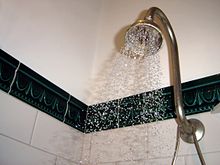Shower: Difference between revisions
→Cultural significance: remove dubious (and fact-tagged for months) claim that most households in the West no longer own bathtubs |
No edit summary |
||
| Line 19: | Line 19: | ||
== Elderly and disabled == |
== Elderly and disabled == |
||
Showering is easier and more secure than [[bathing]], for elderly and disabled people. {{Fact|date=November 2007}} |
Showering is easier and more secure than [[bathing]], for elderly and disabled people as it requires less effort to step out of and also presents a lower risk of slipping and falling. {{Fact|date=November 2007}} |
||
{{Sectstub}} |
{{Sectstub}} |
||
Revision as of 10:50, 12 February 2008
This article may require copy editing for grammar, style, cohesion, tone, or spelling. (June 2007) |
It has been suggested that Steam shower be merged into this article. (Discuss) Proposed since May 2007. |

A shower is the act of spraying water on the body, or a device built for that purpose. When 'taken' for personal hygiene, soap or detergent are often used to aid washing of the skin, and shampoo to aid hair washing. Showering generally uses less water and energy than taking a bath. A full bathroom may include a shower, but a half bathroom will not.
History
The hygiene regimen in the form of a shower goes back to the time of the Greeks, as evidenced by extant vases and murals.[1]
During the Scottish Enlightenment Lord Monboddo showered every morning with cold water on his front porch to emulate the Greeks and profess his belief in the practice as healthful;[2] his habit, while eccentric, was well publicized with the intelligentsia of that era. Another step toward the spread of showering was when the Prussian military installed showering rooms in their barracks in 1879.
This section needs expansion. You can help by adding to it. |
Cultural significance

Showering in the Western World is mostly part of a daily routine, but is also practiced for wellness and relaxation. Showering has today largely replaced bathing.
Showering procedure
Showering results in a few phases, in which the skin, and usually the hair, are wet with water. Then the cleansing products are applied, allowed to work, and subsequently rinsed out. If necessary, soaping and rinsing is re-performed.
Elderly and disabled
Showering is easier and more secure than bathing, for elderly and disabled people as it requires less effort to step out of and also presents a lower risk of slipping and falling. [citation needed]
This section needs expansion. You can help by adding to it. |
Purpose
Various purposes of showering include routine hygiene, as well as safety (as in chemical spills, mass decontamination, etc.).
Structure and designs
There are free-standing showers, but also showers which are integrated into a bathtub. Showers are separated from the surrounding area through watertight curtains (shower curtain), sliding doors, or folding doors, in order to protect the space from spraying water. There are seldom floor-level showers. Here, the wall and floor of the shower areas are tiled or otherwise made waterproof.
Places such as a swimming pool, a locker room, and a military facility, have multiple showers. There may be shower rooms without divisions (typically sex-segregated) or shower stalls (typically open at the top; often in shower rooms which are sex-segregated anyway).
Anthony David Rueli of the University of Massachusetts researched the aspect of why shower curtains billow inwards during showering ("shower-curtain effect") and received for it the Ig Nobel Prize in 2001.
A shower head is a perforated nozzle that distributes the water over a large solid angle. Thus less water can be used to wet the same area. Low flow shower heads can use water even more efficiently by aerating the water stream. Some shower heads can be adjusted to spray different patterns of water. Hard water may result in calcium and magnesium deposits clogging the head, causing it to lose effectiveness.
Shower curtains
Shower curtains are curtains used in bathtubs with a shower or shower enclosures and are usually made out of vinyl, cloth or plastic. The shower curtain has two main purposes: to provide privacy and to prevent water from flooding the bathroom. Shower curtains usually surround the bath inside the tub and are held up with railings or curtain rods on the ceiling. To accommodate the different types of bathtub shapes, railings can come in different sizes and are flexible in their design. Many people use two shower curtains, one that is inside the tub that can be purely functional or can be decorative as well, and an outer shower curtain, which is purely decorative.
See also
References
- ^ Multicultural Resource Center: Showers
- ^ Cloyd, E.L., James Burnett, Lord Monboddo (1972)
